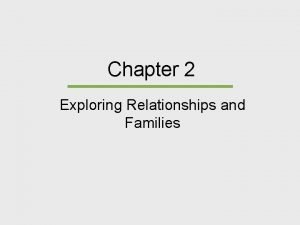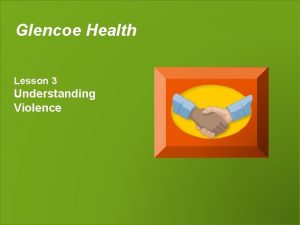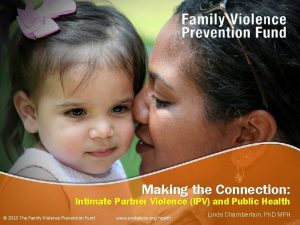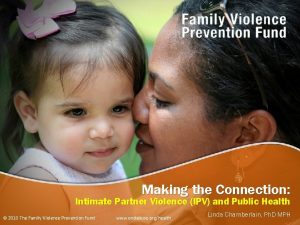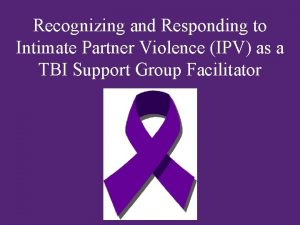Intimate Partner Violence IPV Chapter 18 Intimate Partner








- Slides: 8

Intimate Partner Violence (IPV) Chapter 18

Intimate Partner Violence (IPV) • Current or former emotional, psychological, physical, or sexual abuse between partners in an intimate relationship • Domestic violence is number one cause of ED visits by women – Up to 37% of women are battered

Characteristics of IPV • Battered partner – Lives in terror of next abusive event – Feelings of powerlessness, low self-esteem – Becomes afraid not only for self but also children – Common for social isolation to occur • Batterer – Violence is a learned behavior – Low self-esteem, poor impulse control, and limited tolerance for frustration as well as lack of control – Lack of guilt and unconcern about behavior – Extremely possessive, pathologically jealous, believe in male supremacy

Cycle of Violence • Tension-building phase – Abuser becomes edgy, verbally abusive – Victim feels tense, afraid, like “walking on eggs” • Serious battering phase – Abuser becomes unbearable; violence occurs – Victim may try to cover up the injury or may look for help • Honeymoon phase – Abuser displays loving behavior, makes promises to change – Victim becomes trusting, hoping for change

Nursing Process: Assessment Guidelines • Signs of abuse: burns, bruises, scars, wounds in various stages of healing – Victim may present with high anxiety and stress, complain of somatic symptoms • Questions to ask – Have you been hit, kicked, punched, or otherwise hurt by someone within the past year? If so, who? – Do you feel safe in your current relationship? – Is there a partner from a previous relationship who is making you feel unsafe now? • Always ask if children are also being hurt

Nursing Process: Diagnosis and Outcomes Identification • Common nursing diagnoses – Risk for violence, Risk for injury, Acute/Chronic pain, Risk for trauma, Risk for self- or other-directed violence, Social isolation, Powerlessness, Disabled family coping • Outcomes identification – Most important outcome is to see the woman opt for safe environment for self and children – Realistically, leaving the abuser is not usually the decision made by the woman; therefore, referrals for safe houses, hotlines, and support groups are important

Nursing Process: Planning and Implementation • Planning – Ensure that victim has a basic safety plan, including how to get out of the house, movement to safe location, bags packed with necessities, code word to use for help • Implementation – Ensure patient receives medical treatment, is interviewed in private, and understands legal rights

Guidelines for Intervention in IPV for the Emergency Department • Ensure medical attention provided • Interview patient in private • Assess in nonthreatening manner information about: sexual abuse, chemical abuse, thoughts of suicide or homicide • Encourage patient to talk about incident, and carefully listen • Assess if patient has safe place to go • Identify if patient wishes to press charges and facilitate this process • If patient not ready to take action, refer to community resources






